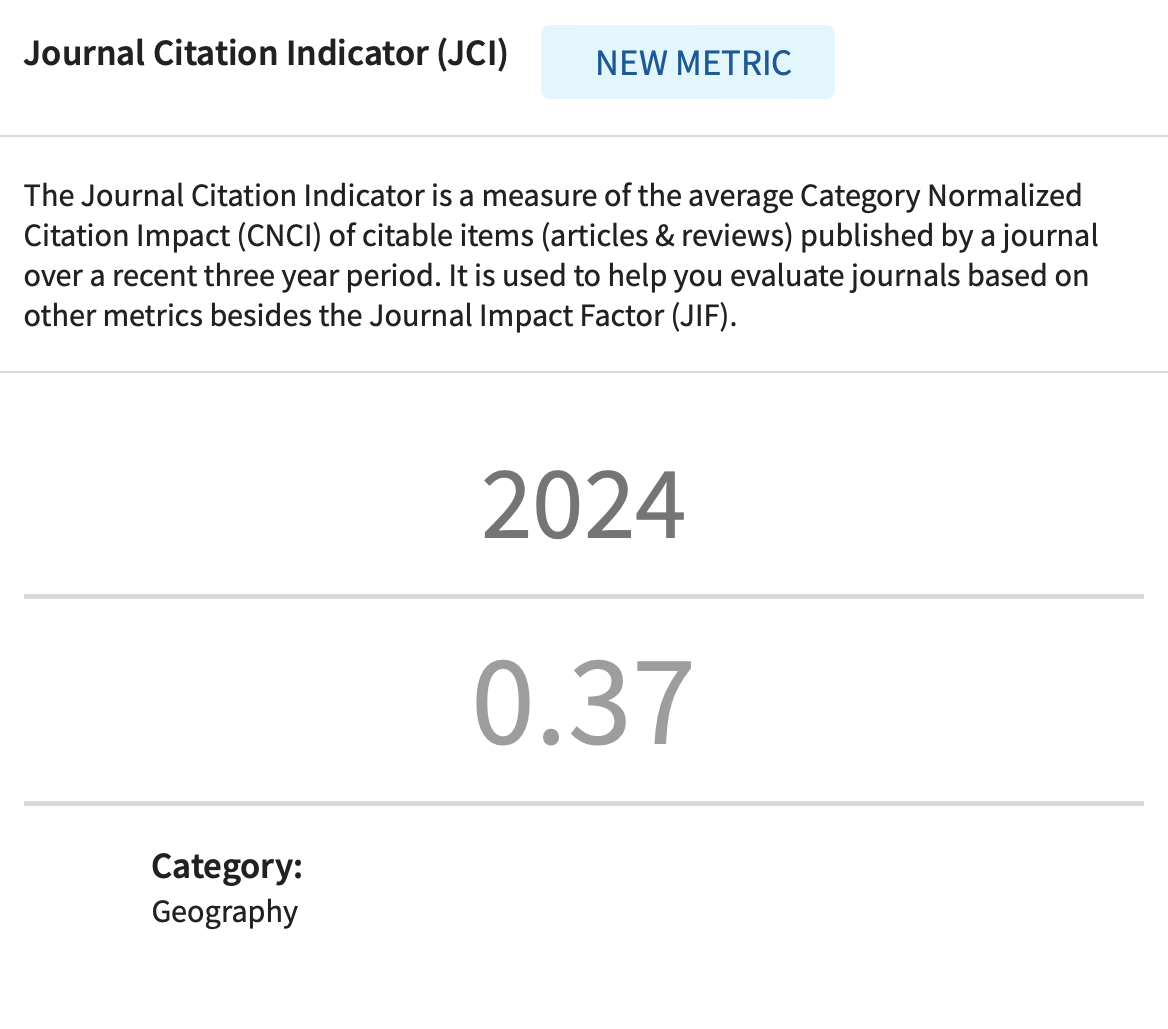MODELING THE RELATIONS BETWEEN RELIGIOSITY, ETHNIC AND CONFESSIONAL IDENTITY IN THE CONTEXT OF SOCIETAL SECURITY IN RUSSIA’S ASIAN BORDERLANDS
DOI:
https://doi.org/10.2298/IJGI241116004MKeywords:
religious identity, ethnicity, societal security, Altai krai, Republic of AltaiAbstract
The religion in a contemporary world still preserves strong cultural and social dimensions, ensuring diversity of modern societies, social integration, and spiritual development. In border territories, connecting culturally divergent countries, religiosity takes on fanciful shapes, reflecting historically driven patterns of resettlement of peoples and natural relationship with ethnic and confessional identities. Based on the results of sociological surveys in two regions of Russia (the Altai krai and the Republic of Altai, n = 981, structured interviews) and the Centrality Religiosity Scale (CRS), this study explores different facets of interdependence between subjectively defined and test-measured religiosity. Comparing the results with confessional and ethnic self-identification, various indicators of security allow not only the evaluation of similar tools with different functionality, but they also enable receiving insights about the congruity and divergence of religiosity, religion and ethnicity in societies with different ethnic composition. According to the results, the majority of the population in the two regions is rather “episodic” believers. In contrast, the level of high religiosity is more often found among women, residents of the national republic, and Buddhists. The highly religious Orthodox population is about 5.2%, and confessions differ not only by their dogmas and practices, but also by the configuration of dimensions of religiosity among adepts. In comparison with the CRS index, self-evaluation gives more smoothed results, showing that non-believers have higher degrees of personally defined religiosity. Statistical modeling shows that security is also a multidimensional construct, having different facets, and the salience of these facets depends on the importance of the religiosity dimension.
Article metrics
References
Antes, P. (2008). Religious Borders in Decomposition. Eurolimes, 5, 152–159. https://citeseerx.ist.psu.edu/document?repid=rep1&type=pdf&doi=ea15193e303a5e457f80cbc1f0e9ea9bc48d0a2d
Ashforth, A. (2010). Human Security and Spiritual Insecurity. Why the Fear of Evil Forces Needs to Be Taken Seriously. Georgetown Journal of International Affairs, 9(1), 99–106. https://hdl.handle.net/2027.42/116822
Seiple, R. A., & Hoover, D. R. (Eds.). (2004). Religion and Security: The New Nexus in International Relations. Rowman & Littlefield.
Bellah, R. N. (2007). Reading and misreading" habits of the heart". Sociology of Religion, 68(2), 189–193. https://doi.org/10.1093/socrel/68.2.189
Berger, P. (Ed.). (1999). The Desecularization of the World: Resurgent Religion and World Politics. Eerdmans. https://doi.org/10.4000/assr.20264
Bogatova, O. A. (2016). Sociologicheskoe izmerenie religioznoj identichnosti v polijetnicheskom regione [Sociological measurement of religious identity in a multi-ethnic region]. Scientific Result. Sociology and Management, 2(3), 11–19. https://doi.org/10.18413/2408-9338-2016-2-3-11-19
Borisova, O. N., & Pavlyutkin, I. V. (2019). Variativnost' modelej sovremennoj gorodskoj mnogodetnosti: vozrozhdenie tradicii, novye braki ili setevye jeffekty? [Variability of Models of Modern Urban Large Families: Revival of Traditions, New Marriages or Network Effects?] Universe of Russia, 28(4), 128–151. https://doi.org/10.17323/1811-038X-2019-28-4-128-151
Breskaya, O. Yu. (2011). Izuchenie religioznosti: k neobhodimosti integral'nogo podhoda [Study of Religiosity: To the Need of Integral Approach]. Sociological studies, 12, 77–87. https://www.isras.ru/files/File/Socis/2011-12/Breskaya.pdf
Bullard, G. (2016, April 22). The World’s Newest Major Religion: No Religion. National Geographic Magazine. http://news.nationalgeographic.com/2016/04/160422-atheism-agnostic-secular-nones-rising-religion.html
Davie, G. (1990). Believing Without Belonging: Is This the Future of Religion in Britain?. Social Compass, 37(4), 455–469. https://doi.org/10.1177/003776890037004004
Divisenko, K. S., & Divisenko, O. A. (2017). Social'noe izmerenie religioznosti: opyt jempiricheskogo issledovanija [Social dimension of religiosity: experience of empirical research]. Sociology in Petersburg Today, 8, 91–110. https://cyberleninka.ru/article/n/sotsialnoe-izmerenie-religioznosti-opyt-empiricheskogo-issledovaniya/viewer
Faulkner, J. E., & De Jong, G. F. (2011). Religiosity in 5-D: An Empirical Analysis. Social Forces, 45(12). 246–254. https://doi.org/10.2307/2574395
Federal State Statistics Service for the Altai Territory and the Republic of Altai. (2024). Results of the 2020 All-Russian Population Census. https://22.rosstat.gov.ru/folder/188258
Fuller, R. C. (2001). Spiritual, but not Religious: Understanding Unchurched America. Oxford University Press.
Glock, C. Y. (1962). On The Study of Religious Commitment. Religious Education, 57(Suppl. 4), 98–110. https://doi.org/10.1080/003440862057S407
Glock, C. Y. (Ed.). (1973). Religion in Sociological Perspective: Essays in the Empirical Study of Religion. Wadsworth.
Haerpfer, C., Inglehart, R., Moreno, A., Welzel, C., Kizilova, K., Diez-Medrano, J., Lagos, M., Norris, P., Ponarin, E., & Puranen B. (Eds.). (2022). World Values Survey: Round Seven – Country-Pooled [Datafile Version 6.0.] JD Systems Institute & WVSA Secretariat. https://doi.org/10.14281/18241.24
Holt, C. L., Clark, E. M., Wang, M. Q., Williams, B. R., & Schulz, E. (2015). The religion–health connection among African Americans: What is the role of social capital? Journal of Community & Applied Social Psychology, 25(1), 1–18. https://doi.org/10.1002/casp.2191
Huber, S., & Huber, O. W. (2012). The Centrality of Religiosity Scale (CRS). Religions, 3(3), 710–724. https://doi.org/10.3390/rel3030710
Huber, S., & Huber, O. W. (2018). The Centrality of Religiosity Scale (CRS) (E. Prutskova & K. Markin, Transl.). Sociology: Methodology, Methods, Mathematical Modeling (Sociology: 4M), 47, 144–171. https://www.soc4m.ru/index.php/soc4m/article/view/6501
Huber, S., Ackert, M., & Scheiblich, H. (2020). Religiosität in unterschiedlichen Religionskulturen – Vergleiche auf der Basis der Centrality of Religiosity Scale [Religiosity in different religious cultures – comparisons based on the Centrality of Religiosity Scale]. Cultura & Psyché, 1(1–2), 171–185. https://doi.org/10.1007/s43638-020-00007-3
Joshanloo, M., & Daemi, F. (2015). Self‐esteem mediates the relationship between spirituality and subjective well‐being in Iran. International Journal of Psychology, 50(2), 115–120. https://doi.org/10.1002/ijop.12061
Karpov, V., Lisovskaya, E., & Barry, D. (2012). Ethnodoxy: How popular ideologies fuse religious and ethnic identities. Journal for the Scientific Study of Religion, 51(4), 638–655. https://doi.org/10.1111/j.1468-5906.2012.01678.x
Khlopkova, O. V. (2020). Transformacija podhodov k issledovaniju religioznosti v social'nyh naukah [Transformation of approaches to the study of religiosity in social sciences]. Human. Socium. Society, 2, 122–130.
Kuzovenko, K. Yu., & Mischenko, V. V. (2021). Obosnovanie potrebnosti v glubokoj pererabotke zerna v Altajskom kraja [Justification for the need of deep grain processing in Altai Krai]. Functioning of the Economy of Altai Krai, 13, 144–153.
Lebedev, S. D. (2020). Sociologicheskoe izmerenie religioznosti: k tipologii osnovnyh podhodov [Sociological dimension of religiosity: to the typology of principal approaches]. In V. A. Mansurov (Ed). Sociology and society: traditions and innovations in the social development of regions: Collection of papers of the VI All-Russian Sociological Congress (pp. 4962–4979). https://doi.org/10.19181/kongress.2020.584
Loewenthal, K. M., MacLeod, A. K., & Cinnirella, M. (2002). Are women more religious than men? Gender differences in religious activity among different religious groups in the UK. Personality and Individual Differences, 32(1), 133–139. https://doi.org/10.1016/s0191-8869(01)00011-3
Máté-Tóth, A., & Povedák, K. (Eds.). (2024). Religion as securitization in Central and Eastern Europe. Routledge. https://doi.org/10.4324/9781003380597
Maximova, S. G., Omelchenko, D. A., & Noyanzina, O. E. (2024). Spiritual Security in Border Regions Evaluated by People with Different Levels of Religiousness: Does Faith Matter? Religiovedenie [Study of Religion], 2, 150–166. https://religio.amursu.ru/images/Volumes/2024/2/13_--.pdf
Maximova, S. G., Surtaeva, O. V., Omelchenko, D. A., & Velikzhanina, K. A. (2024). Religioznost' zhenshhin prigranichnyh regionov Rossii: obshhie harakteristiki i regional'naja specifika [Women’s Religiosity in Border Regions of Russia: General Characteristics and Regional Peculiarities]. Society and Security Insights, 7(2), 69–90. https://journal.asu.ru/ssi/article/view/15484/13142
Manankova, T. I. (2017). Prirodopol'zovanie respubliki Altai i ekologicheskie problemy [Natural resource use in the Altai Republic and environmental issues]. In A. M. Marinin (Ed.), Izvestiya Altayskogo respublikanskogo otdeleniya Russkogo geograficheskogo obshchestva: Materialy mezhdunarodnoy nauchno-prakticheskoy konferentsii, Gorno-Altaysk, 27 oktyabrya 2017 goda (Issue 5, pp. 116–120). Gorno-Altaysk State University.
Oreshina, D. А. (2016). «Partnjorskij prihod»: sotrudnichestvo svjashhennosluzhitelej i mirjan kak faktor razvitija social'noj dejatel'nosti v sovremennyh prihodah Russkoj Pravoslavnoj Cerkvi [“Partner Parish": cooperation between clergy and laity as a factor in the development of social activities in modern parishes of the Russian Orthodox Church]. Vestnik PSTGU. Series I: Theology. Philosophy. Religiology, 5(67), 99–120. https://doi.org/10.15382/sturI201667.99-120
Ponomarev, M V. (2023). Zakreplenie imperativa tradicionnyh duhovno–nravstvennyh cennostej: religiozno–institucional'nyj aspekt [Consolidating the imperative of traditional spiritual and moral values: religious and institutional aspect]. Social-Humanitarian Knowledge, 12, 119–122. https://cyberleninka.ru/article/n/zakreplenie-imperativa-traditsionnyh-duhovno-nravstvennyh-tsennostey-religiozno-institutsionalnyy-aspekt/viewer
Price, J., & Bartoli, A. (2012). Spiritual Values, Sustainable Security, and Conflict Resolution. In C. Seiple, D. R. Hoover, & P. Otis (Eds.), The Routledge Handbook of Religion and Security (pp. 160–170). Routledge. https://doi.org/10.4324/9780203102312.ch15
Puga-Gonzalez, I., Voas, D., Kiszkiel, L., Bacon, R. J., Wildman, W. J., Talmont-Kaminski, K., & Shults, F. L. (2022). Modeling fuzzy fidelity: Using microsimulation to explore Age, period, and cohort effects in secularization. Journal of Religion and Demography, 9(1–2), 111–137. https://doi.org/10.1163/2589742x-bja10012
Schmidt-Leukel, P. (2020). Why Live with Only One Religion?: Some Notes on the Phenomenon of Multi-Religious Identity. Studies in Interreligious Dialogue, 30(1), 1–19. https://doi.org/10.2143/SID.30.1.3288646
Schnabel, L. (2018). More religious, less dogmatic: Toward a general framework for gender differences in religion. Social Science Research, 75, 58–72. https://doi.org/10.1016/j.ssresearch.2018.06.010
Seiple, C., Hoover, D. R., Otis, P. (Eds.), (2012). The Routledge Handbook of Religion and Security. Routledge. https://doi.org/10.4324/9780203102312
Shi, S., Peng, C., Zhang, Q., Wen, M., Chen, Y. C., & Yip, P. S. (2025). Does Religion Buffer the Negative Effects of Economic and Subjective Poverty on Life Satisfaction? Longitudinal Evidence from Hong Kong. Applied Research in Quality of Life. http://dx.doi.org/10.1007/s11482-025-10422-4
Smith, T. W. (2021). The General Social Surveys. In J. C. Barnes & D. R. Forde (Eds.), The Encyclopedia of Research Methods in Criminology and Criminal Justice (pp. 54–59). https://doi.org/10.1016/B978-0-08-097086-8.44080-8
Stark, R., & Glock, С. Y. (1968). American Piety: The Nature of Religious Commitment. Berkley. https://archive.org/details/americanpietynat0000unse/mode/2up
Storm, I. (2009). Halfway to heaven: Four types of fuzzy fidelity in Europe. Journal for the Scientific Study of Religion, 48(4), 702–718. https://doi.org/10.1111/j.1468-5906.2009.01474.x
Tkáčová, H., Pavlíková, M., Tvrdoň, M., & Prokopyev, A. I. (2021). Existence and prevention of social exclusion of religious university students due to stereotyping. Bogoslovni vestnik, 81(1), 199–223. https://doi.org/10.34291/bv2021/01/tkacova
Trochowska-Sviderok, K. (2021). Sustainable security: revolution or utopia?. European Research Studies Journal, 24(2), 369–395. https://www.um.edu.mt/library/oar/handle/123456789/82059
Villani, D., Sorgente, A., Iannello, P., & Antonietti, A. (2019). The role of spirituality and religiosity in subjective well-being of individuals with different religious status. Frontiers in Psychology, 10, Article 1525. https://doi.org/10.3389/fpsyg.2019.01525
Voas, D., & Day, A. (2010). Recognizing Secular Christians: Toward an Unexcluded Middle in the Study of Religion. The Association of Religion Data Archives. https://www.thearda.com/ARDA/rrh/papers/guidingpapers/Voas.pdf
Watts, G. (2022). The religion of the heart: “Spirituality” in late modernity. American Journal of Cultural Sociology, 10(1), 1–33. https://doi.org/10.1057/s41290-020-00106-x
Wixwat, M., & Saucier, G. (2021). Being spiritual but not religious. Current Opinion in Psychology, 40, 121–125. https://doi.org/10.1016/j.copsyc.2020.09.003
Zabaev, I. V., & Prutskova, E. V. (2012). Obshhina pravoslavnogo hrama: prostranstvennaja lokalizacija i faktory formirovanija (na primere g. Moskvy) [The community of the Orthodox temple: localization and factors of formation (on the example of Moscow)]. Vestnik PSTGU. Series I: Theology. Philosophy. Religious Studies, 3(41), 57–67. https://cyberleninka.ru/article/n/obschina-pravoslavnogo-hrama-prostranstvennaya-lokalizatsiya-i-faktory-formirovaniya-na-primere-g-moskvy/pdf
Downloads
Published
How to Cite
Issue
Section
License
Copyright (c) 2025 Journal of the Geographical Institute “Jovan Cvijić” SASA

This work is licensed under a Creative Commons Attribution 4.0 International License.











